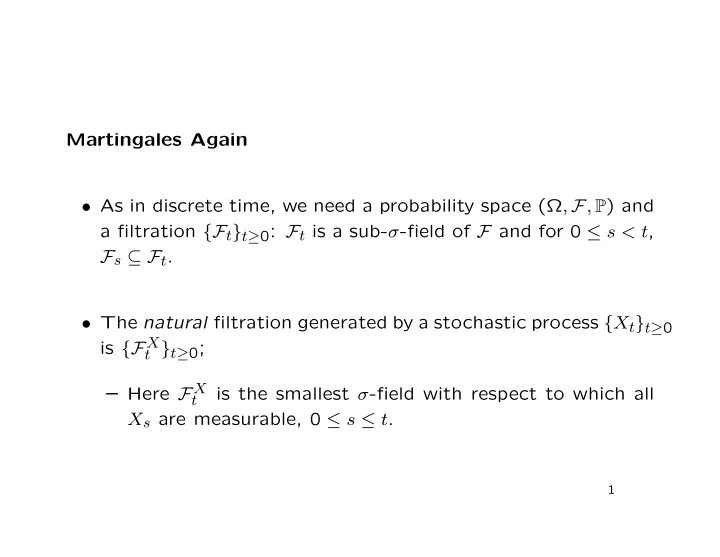

Martingales Again • As in discrete time, we need a probability space (Ω , F , P ) and a filtration {F t } t ≥ 0 : F t is a sub- σ -field of F and for 0 ≤ s < t , F s ⊆ F t . • The natural filtration generated by a stochastic process { X t } t ≥ 0 is {F X t } t ≥ 0 ; – Here F X is the smallest σ -field with respect to which all t X s are measurable, 0 ≤ s ≤ t . 1
� � • { M t } t ≥ 0 is a P , {F t } t ≥ 0 -martingale if E P [ | M t | ] < ∞ for all t ≥ 0 , and for any 0 ≤ s ≤ t , E P [ M t |F s ] = M s . � � • More generally, { M t } t ≥ 0 is a local P , {F t } t ≥ 0 -martingale if there exists a sequence of stopping times { T n } n ≥ 1 such that: � � – { M t ∧ T n } t ≥ 0 is a P , {F t } t ≥ 0 -martingale for each n , and – P [ T n → ∞ as n → ∞ ] = 1. 2
• Suppose that { W t } t ≥ 0 is standard Brownian motion, and {F t } t ≥ 0 is the natural filtration. Then: � � – { W t } t ≥ 0 is a -martingale; P , {F t } t ≥ 0 � � � � W 2 t − t t ≥ 0 is a P , {F t } t ≥ 0 -martingale; – � � �� σW t − σ 2 � � exp is a P , {F t } t ≥ 0 -martingale. 2 t – t ≥ 0 3
� � • Optional Stopping Theorem: if { M t } t ≥ 0 is a continuous P , {F t } t ≥ 0 - martingale (or more generally, almost surely c` ag ), and if adl` τ 1 ≤ τ 2 are two bounded stopping times, then � < ∞ , � | M τ 2 | E and � = M τ 1 , � M τ 2 | F τ 1 E with P -probability 1. 4
• We can use this theorem for instance to find the moment generating function (Laplace transform) of the distribution of the hitting time T a , � e − θT a � E . • Suppose that a > 0; recall that σW t − σ 2 � � M t = exp 2 t is a martingale. • Take τ 1 = 0 and τ 2 = T a . 5
• So � e − σ 2 � ? � � = e σa E 2 T a 1 = M 0 = E M T a . • The argument fails at “ ? =”, because T a is not bounded. • It can be fixed by taking τ 2 = T a ∧ n , and letting n → ∞ . • Correct: � � 1 = M 0 = E M T a ∧ n � � � � = E + E M T a ∧ n 1 { T a ≤ n } M T a ∧ n 1 { T a >n } � � � � � � = E + E → E + 0 . M T a 1 { T a ≤ n } M n 1 { T a >n } M T a 6
• So � e − σ 2 � = e − σa , 2 T a E or √ � e − θT a � = e − 2 θa . E • For a < 0, we use − σW t − σ 2 � � M t = exp 2 t as the martingale, and find the general result √ � e − θT a � = e − 2 θ | a | . E 7
Recommend
More recommend